Sthenoteuthis pteropus
Michael Vecchione and Richard E. YoungCharacteristics
- Arms
- Hectocotylus with 22-26 suckers.
 Click on an image to view larger version & data in a new window
Click on an image to view larger version & data in a new window
Figure. Hectocotylus of Sthenoteuthis pteropus. Drawing from Roeleveld (1998).
- Hectocotylus with 22-26 suckers.
- Tentacles
 Click on an image to view larger version & data in a new window
Click on an image to view larger version & data in a new window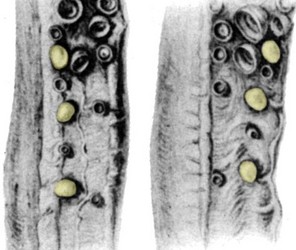
Figure. Oral views of the left and right tentacle bases of S. pteropus showing the relationship between the carpal knobs (colored yellow) and the number of more proximal suckers. Note that the proximal carpal locking-sucker is absent from the tentacle on the right. Drawing modified from Pfeffer (1912).
-
- Funnel/mantle locking-apparatus
- Funnel and mantle components not fused.
- Photophores
 Click on an image to view larger version & data in a new window
Click on an image to view larger version & data in a new window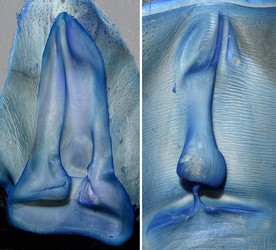
Figure. Frontal views of the funnel (left) and mantle (right) components of the funnel/mantle locking-apparatus of S. pteropus showing the absence of any tearing of the cartilage and therefore an absence of fusion of the two components. Photographs by R. Young.
- Funnel and mantle components not fused.
Life History
S. pteropus spawns primarily in specific regions on either side of the tropical Atlantic (Zuev and Nikolsky, 1993). A detailed study from the tropical Atlantic, found paralarval growth of S. pteropus is comparable to that of O. bartramii (ie, ca 7 mm ML at 30 days????) and proboscis separation in S. pteropus occurred at a ML of 8.5 mm and an age of 33-35 days (Arkhipkin and Mikheev, 1992). In this study, based on statolith examination, they recognized a "dark zone" in the statolith characterized by the lower transparency of the statolith and the width of the increments. They found that this period ended at about 100-110 days at a ML of about 100 mm which they considered to be the end of the juvenile period for S. pteropus.References
Arkhipkin and Mikheev. 1992.
Pfeffer, G. 1912. Die Cephalopoden der Plankton-Expedition. Ergebniss der Plankton-Expedition der Humboldt-Stiftung. 2: 1-815.
Roeleveld, M. A. 1988. Generic interrelationships within the Ommastrephidae (Cephalopoda). P.277-314. In: M. R. Clarke and E. R. Trueman (eds.). The Mollusca. Vol. 12. Paleontology and Neontology of Cephalopods. Academic Press, N.Y., 355pp. (with permission from Elsevier).
Roper, C. F. E. 1963. Observations in Ommastrephes pteropus (Steenstrup, 1855), with notes on its occurrence in the family Ommastrephidae (Mollusca: Cephalopoda). Bull. Mar. Sc., 13: 343-353.
Zuev and Nikolsky. 1993.
About This Page

National Museum of Natural History, Washington, D. C. , USA

University of Hawaii, Honolulu, HI, USA
Page copyright © 2015 and
 Page: Tree of Life
Sthenoteuthis pteropus .
Authored by
Michael Vecchione and Richard E. Young.
The TEXT of this page is licensed under the
Creative Commons Attribution-NonCommercial License - Version 3.0. Note that images and other media
featured on this page are each governed by their own license, and they may or may not be available
for reuse. Click on an image or a media link to access the media data window, which provides the
relevant licensing information. For the general terms and conditions of ToL material reuse and
redistribution, please see the Tree of Life Copyright
Policies.
Page: Tree of Life
Sthenoteuthis pteropus .
Authored by
Michael Vecchione and Richard E. Young.
The TEXT of this page is licensed under the
Creative Commons Attribution-NonCommercial License - Version 3.0. Note that images and other media
featured on this page are each governed by their own license, and they may or may not be available
for reuse. Click on an image or a media link to access the media data window, which provides the
relevant licensing information. For the general terms and conditions of ToL material reuse and
redistribution, please see the Tree of Life Copyright
Policies.
- First online 15 August 2010
- Content changed 11 October 2015
Citing this page:
Vecchione, Michael and Richard E. Young. 2015. Sthenoteuthis pteropus . Version 11 October 2015 (temporary). http://tolweb.org/Sthenoteuthis_pteropus/77448/2015.10.11 in The Tree of Life Web Project, http://tolweb.org/




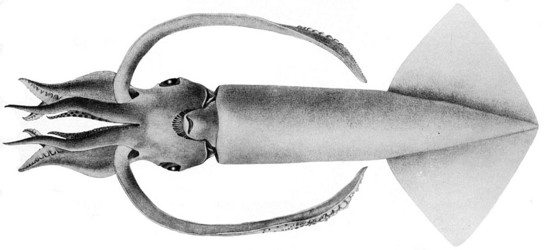
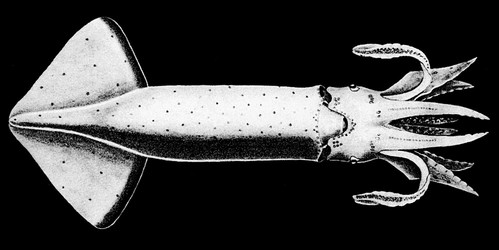
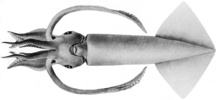


 Go to quick links
Go to quick search
Go to navigation for this section of the ToL site
Go to detailed links for the ToL site
Go to quick links
Go to quick search
Go to navigation for this section of the ToL site
Go to detailed links for the ToL site